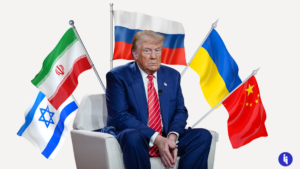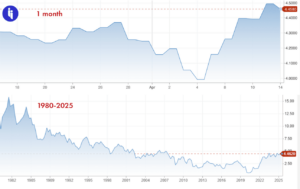The top economic representatives of the US (Scott Bessent) and China (He Lifeng) just emerged from a weekend of talks at the Swiss ambassador’s UN residence on Lake Geneva, and announced they’ll lower tariffs and de-escalate their trade war.
- The US will cut its tariffs from 145% to 30%, while…
- China will drop its 125% tariffs to 10%.
In practice, this means trade between the world’s two biggest economies is once again viable, though this is just a 90-day pause while they find a more permanent solution.
In the meantime, both sides are still claiming this weekend’s talks were the result of the other’s desperation, so as talks continue, it’s worth exploring: who has the cards here?
Stay on top of your world from inside your inbox.
Subscribe for free today and receive way much more insights.
Trusted by 127,000+ subscribers
No spam. No noise. Unsubscribe any time.
That depends on three questions:
- Who can find substitute goods?
Friday saw zero US-bound ships depart China for the first time in recent history (excluding Covid), while China’s manufacturing activity has started to contract. Meanwhile, US ports like LA just saw arrivals drop by a third last week, and US trucking stocks have plunged.
All that to say… this trade war is moving from the front pages onto our world’s shelves. But can’t we just buy from elsewhere? Sure, the US can get cheap jeans and flatscreens from (say) Bangladesh or Mexico, while China is already getting more soy from Brazil.
The challenge, however, is when there’s no substitute: for the US, despite years of diversification efforts, it still relies on China’s rare earths, solar panels, and batteries, while China still needs the US for advanced chips, pharma, and key industrial chemicals.
So, who’s got the cards? Both Beijing and DC.
2. Who can find substitute markets?
- China is way more dependent on selling stuff to the US than vice versa:
- China exports triple to the US what the US sells to China, and
- China’s exports to the US alone are ~2.8% of China’s GDP (it’s <0.5% for the US)
So, US leaders have cited these figures as evidence why China needs the US more.
But as this trade war moves into boardrooms, China’s firms have already started selling a) to the US via third countries, b) to other markets, and c) back home at steep discounts (though there are costs and challenges with each).
It’s a little trickier for the US, with its China export base more concentrated on soy, oil, jets, and chips. China is the world’s single-largest buyer across each of those categories, and there’s just nobody else out there willing or able to buy that much US soy or Boeings.
So, who’s got the cards? Both Beijing and DC
3. And… who can withstand the politics?
As the head of China’s Communist Party, Xi can silence local reporting on the economic fallout, and quash any related unrest, while his state outlets continue to talk tough.
As for Trump, he’ll face the democratic rigours of a free press, opinion polls, and next year’s mid-terms. And that might shape his negotiation timeline or willingness to shift.
So, who’s got the cards? As an unelected authoritarian, Xi might just have an edge.
Anyway, they both have some cards, which might be why they’ve both just de-escalated.
INTRIGUE’S TAKE
America’s big bet was that, by integrating China into the global economy, the US model would win by nudging China to liberalise both its economy and its politics. But Xi has now shown an ability to do the opposite, jujitsu-ing markets to serve his own political strategy.
But timing is everything. History might show that Xi moved too early when he abandoned Deng’s ‘hide and bide’ approach to reveal a more assertive China abroad. And history might show the US has now moved a little late in response.
Meanwhile, the US might’ve also mis-timed its strategy: it makes sense to gather trading partners, then jointly approach China with more leverage. But that happened already — it was called the Trans-Pacific Partnership and would’ve had the US at the helm of a deal covering 40% of global trade. But by the time that deal landed, US public opinion on trade had cratered, and both 2016 candidates disavowed it.
Even if a future administration wants to revisit that kind of strategy, 2025 isn’t 2016: China is now the top trade partner for more countries than the US by ~two-to-one, and those capitals will now be more reluctant to jeopardise their China ties.
Still, with this de-escalation, both Xi and Trump now have space to plan their next move.









